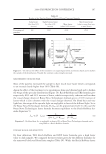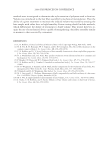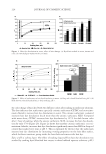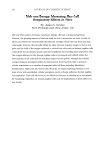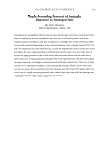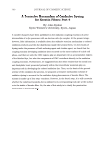2008 TRI/PRINCETON CONFERENCE 243 The best coacervate forming polymers were chosen for further analysis. Objective wet combing studies are shown in Table II. Polymers (0.5%) were formulated into 15.5% SLES-2 and 2.6% DSCADA. Of the six synthetic polymers evaluated, only PQ7 and Blend A exhibited signifi cant wet combing reduction, and neither was as effective as ei- ther PQ10 or at least one of the cationic guar polymers. It should be noted that objective Table II Objective Wet-Comb Analysis on 8-Hour Bleached Hair. Polymer % Combing reduction PQ11a 8 PQ6 0 PQ47 0 PQ7a 29 PQ7b 16 Blend A 38 Blend B 19 PQ10 (LMW) 70 PQ10 (HMW) 63 Cartionic guar 54 Cartionic guar 31 All polymers were tested at 0.5% active in 15.5% sodium laureth sulfate-2 (SLES-2) and 2.6% disodium cocoamphodiacetate (DSCADA). Table I List of Commercial Polymers Evaluated for Conditioning on Hair. INCI name (composition) Structure PQ-11 (polyvinyl pyrrolidone and dimethyl aminoethylmethacrylate— DMAEMA) 2 manufacturers PQ-47 (acrylic acid, methyl acrylate and methacrylamidopropyltrimonium chloride—MAPTAC) PQ-7 (acrylamide and dimethyl diallyl ammonium chloride— DADMAC) 3 manufacturers PQ-6 (dimethyl diallyl ammonium chloride— DADMAC) 2 manufacturers Acrylamidopropylatrimonium chloride/acrylamide copolymer Blend A PQ7 + Acrylamidopropyltrimonium chloride – APTAC/acrylamide copolymer Blend B
JOURNAL OF COSMETIC SCIENCE 244 wet combing is typically performed on damaged (bleached) hair and is therefore a measure of strong conditioning. Silicone deposition studies were performed on the best perform- ing polymers (PQ7 and Blend A). Both polymers showed silicone deposition after two washes when formulated in 15.5% SLES-2 & 2.6% DSCADA. Blend A deposited a sig- nifi cant amount of silicone (~3200 mg/kg) while PQ7 deposited silicone at a level similar to that of cationic guar (~500 mg/kg). Previous studies had shown signifi cant differences in deposition of silicone based on polymer type and silicone particle size (12). For exam- ple, cationic guar tends to deposit high amounts of small particle size silicone (~200 nm) while PQ10 is more effi cient at depositing large particle size silicone (~30 μ). Effi ciency of deposition of varying particle size silicone may similarly be affected by synthetic poly- mer type, but was not investigated in this study. A fi nal study was performed to measure Figure 2. Coacervate curves of various cationic polymers. All polymers were tested at 0.5% active in 15.5% sodium Laureth Sulfate-2 (SLES-2) and 2.6% disodium cocoamphodiacetate (DSCADA).
Purchased for the exclusive use of nofirst nolast (unknown) From: SCC Media Library & Resource Center (library.scconline.org)














































































